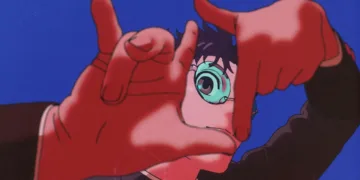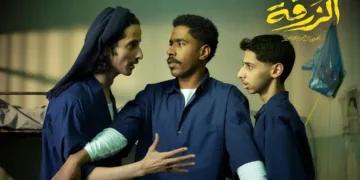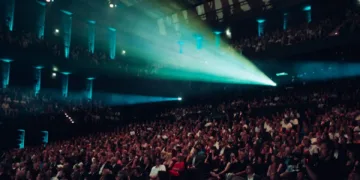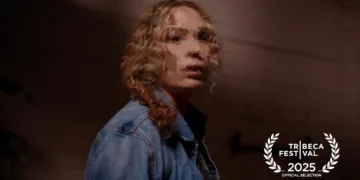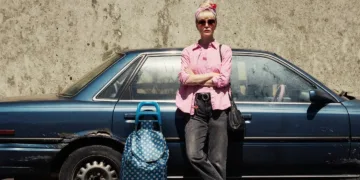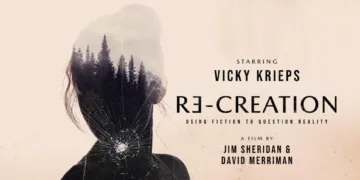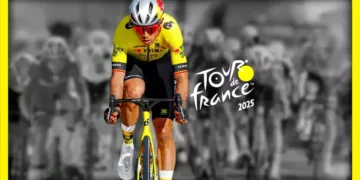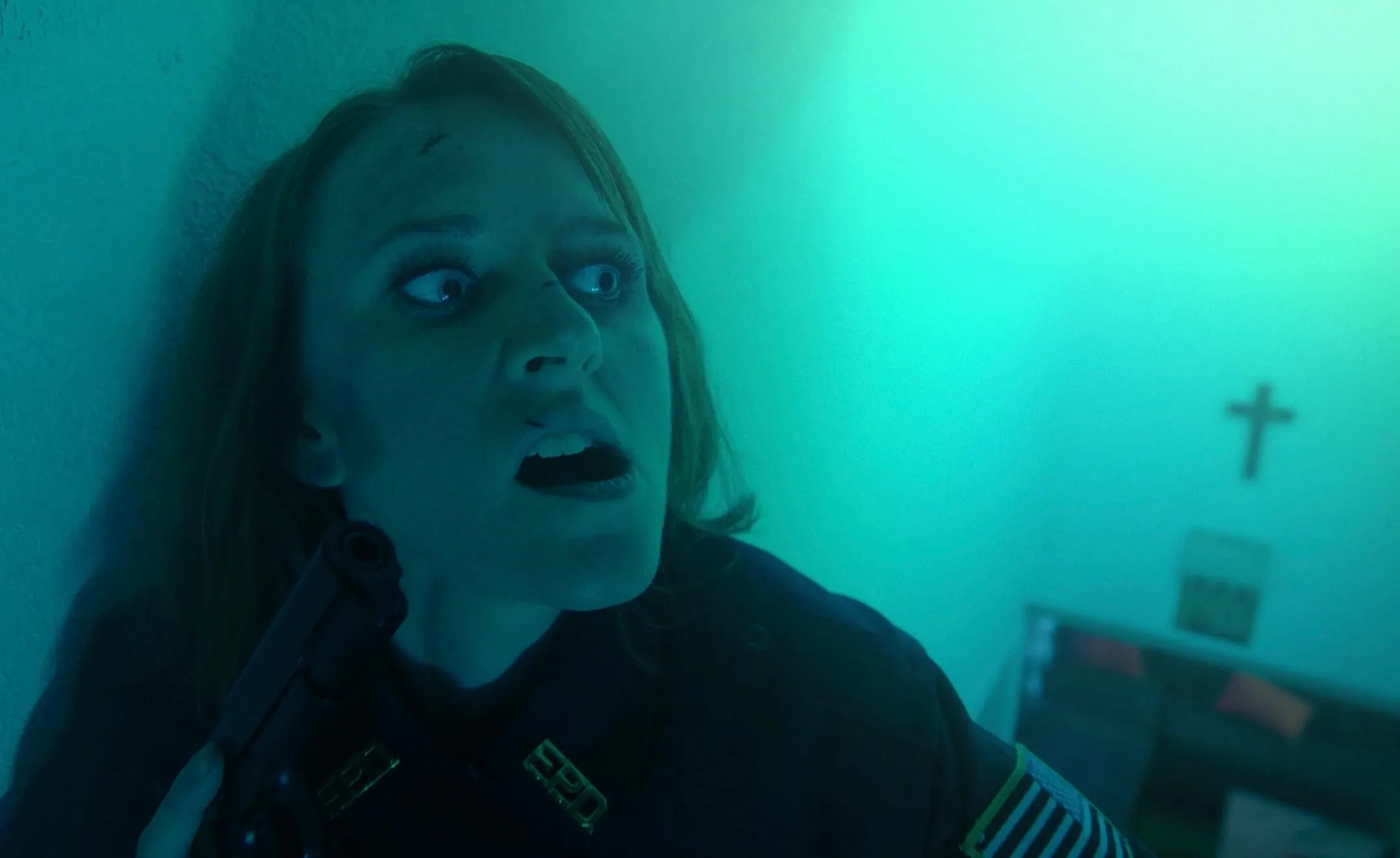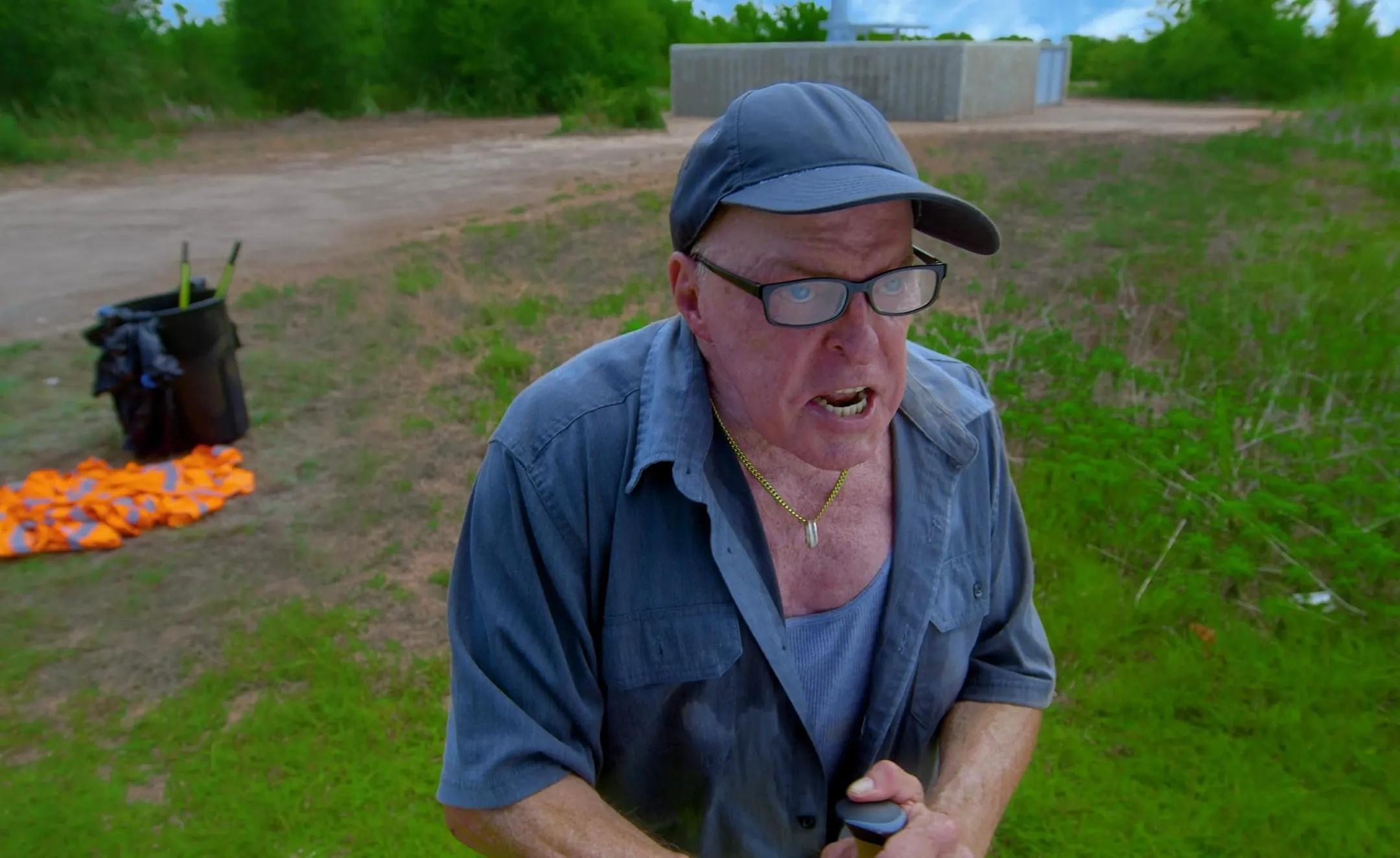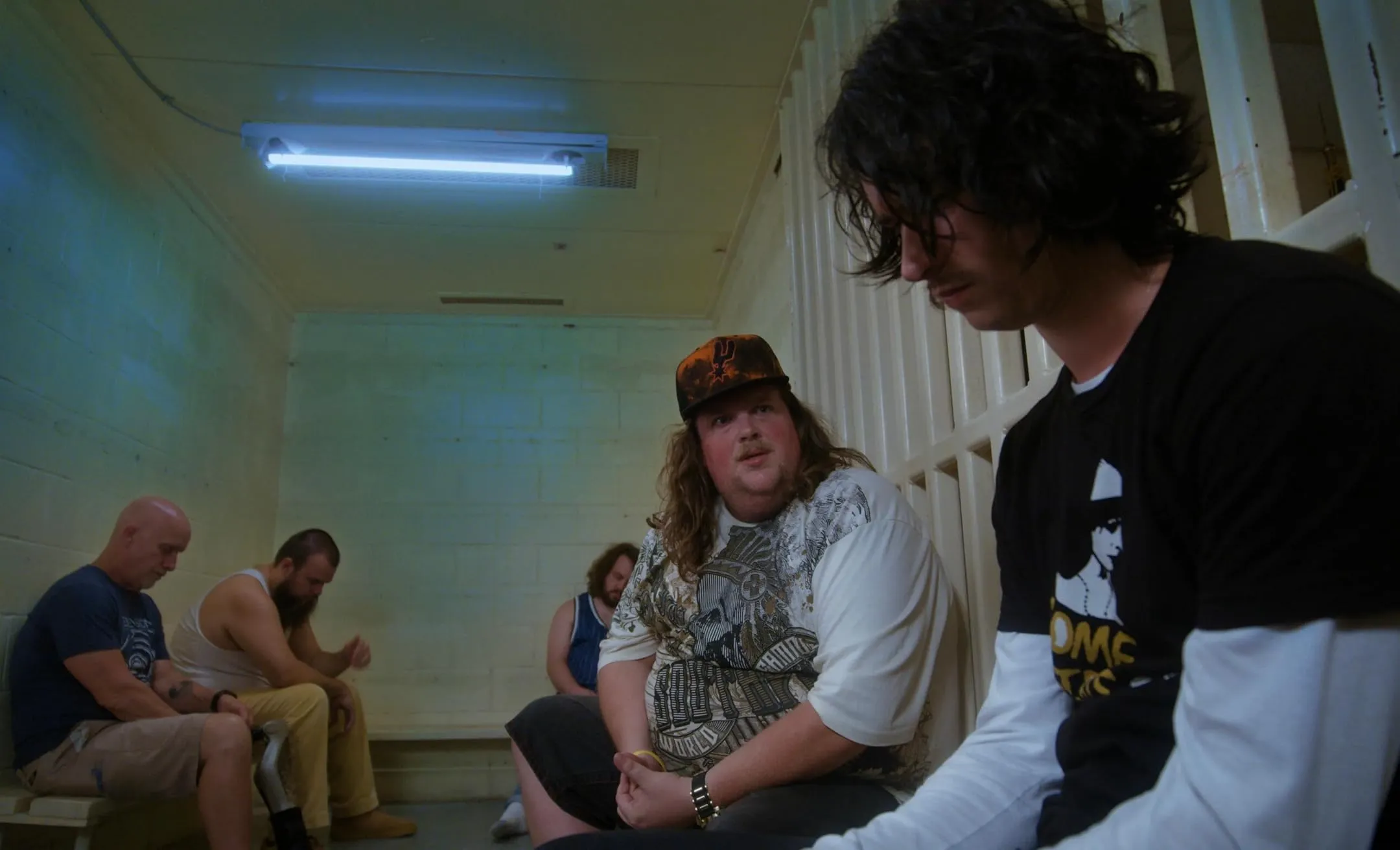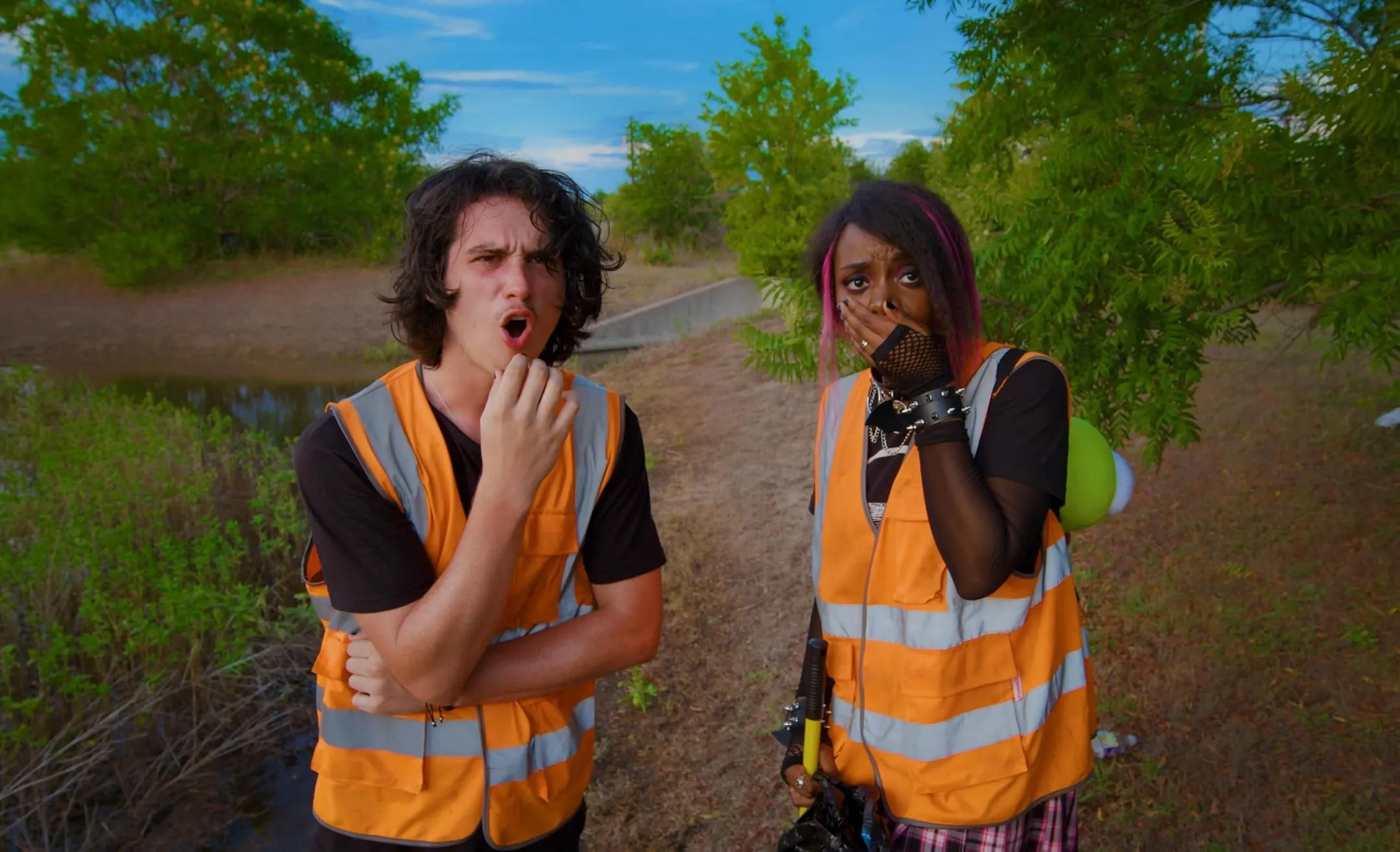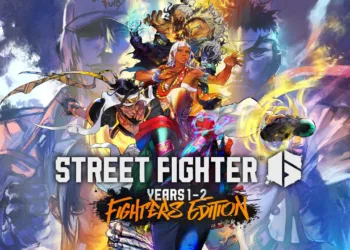Set against the dreary, nondescript backdrop of Pfresno, Texas, circa 2007, Rats! opens the door to a world where reality is as warped as the characters populating it. A town stuck in the purgatory of cultural stagnation, where disembodied hands (pronounced “hahnz”) are casually tossed into the landscape like confetti at a grim carnival.
The film, an absurdist comedy with dark humor and biting social satire, introduces Raphael (Luke Wilcox), an apathetic community college student whose arrest for graffiti spirals him into a convoluted underworld led by the deranged Officer Williams (Danielle Evon Ploeger).
The film quickly unveils its chaotic and nihilistic nature, blending slapstick humor with uncomfortable truths. Raphael’s journey, which pivots from a simple arrest to his forced role as an informant for a lunatic cop convinced his cousin Mateo (Darius Autry) is trafficking nuclear materials, serves as a surreal exploration of small-town paranoia. The film’s absurdity isn’t just a punchline—it’s a means to probe deeper into the contradictions of American life, where the most bizarre characters hold the loudest truths.
Character Dissections: Lost Youth and Madness
At the heart of Rats! lies Raphael (Luke Wilcox), a classic “normie” trying to maintain a semblance of normalcy in a world that has gone completely off the rails. His journey, from a confused 19-year-old slacker to a reluctant informant for a deranged cop, underscores the film’s critique of how conformity is at odds with the chaotic pulse of society.
Raphael’s detachment is palpable, as he stumbles through each absurd situation without truly questioning why he’s stuck in it. The film positions him as the perfect straight man in a universe where the bizarre is the norm (and that, of course, makes him the most relatable character). He’s the audience’s avatar in a town that seems allergic to sanity, his journey less one of growth than one of reluctant adaptation.
Then there’s Officer Williams (Danielle Evon Ploeger)—a towering beacon of excess, her psychotic antics a deliberate deflation of the myth of “the law.” In Williams, the film delivers its most exaggerated authority figure, one whose erratic behavior both challenges and mocks the very systems that are supposed to protect. She’s a walking absurdity, always on the edge of losing control but never quite tipping over. Her unraveling is as much a commentary on the failure of institutions as it is a satire on the manic energies that often fuel them.
In contrast, Mateo (Darius R. Autry) offers the rare moment of calm in this storm, an oddly gentle figure who remains steadfast amidst the chaos. His unassuming nature serves as a stabilizing force in the narrative, a stark reminder of what it means to live authentically in a world gone mad. Mateo, as much as he may seem like a typical stoner archetype, represents a kind of tragic nobility—a person so clearly misunderstood by the world, yet so consistently humane.
Bernadette (Khali Sykes) starts out as a familiar trope—the manic pixie dream girl—but she is quickly woven into the film’s fabric as a more complex figure. Through her connection with Raphael, she transitions from just a love interest into an active participant in the absurd events unfolding around them. This shift not only defies expectations but also serves to critique the limitations of such stereotypical roles, offering a fresh take on a character who could easily have been relegated to the background.
The supporting characters—Nestor, the squatter, and the quirky neighbors—populate the fringes of the narrative, providing both humor and a sense of unsettling realism. They’re less fleshed out but no less impactful, each adding a layer of eccentricity that underscores the film’s larger critique of societal dysfunction.
The Rot Beneath: Exploring Decay and Disillusionment
Pfresno, Texas, the setting of Rats!, isn’t just a backdrop; it’s a living, breathing symbol of social stagnation. It’s a place where the streets feel more like holding cells than avenues for escape, and where the residents—whether through complacency or ignorance—are resigned to the decay around them.
The film’s setting conjures up an image of a town trapped in time, much like the characters who inhabit it. From the strip malls to the dilapidated backyards, Pfresno serves as a microcosm for a broader societal malaise. This isn’t just a town; it’s America on a loop, stuck in its own contradictions and complacencies.
In a sense, the oddities of the town mirror the fractured psyche of a society that is, at once, obsessed with progress and yet continually spiraling toward decay. The film’s almost obsessive focus on bizarre details—the disembodied hands (or “hahnz”) scattered across town, the increasingly bizarre characters—becomes a reflection of how societal neglect manifests in the most surreal ways. These quirks aren’t mere comedic devices; they’re hints at a rot festering beneath the surface, a rot that isn’t confined to the decaying infrastructure of Pfresno but extends into the very heart of American life.
The absurd characters, each more outlandish than the next, serve as exaggerated stand-ins for the cultural and political failings of the country. Officer Williams, a psychotic figure of unchecked authority, is the embodiment of police corruption and the distortions of power. The film’s biting critique of gun culture, law enforcement, and societal apathy comes wrapped in layers of absurdity, but it’s clear that the film’s humor is a vehicle for a deeper political commentary. In Rats!, America isn’t just a land of excess; it’s a land of blind excess, a country clinging to outdated ideals while circling the drain.
At the center of this chaos stands Raphael, the film’s disillusioned protagonist, whose desire to escape Pfresno encapsulates the frustrations of an entire generation. His yearning to leave isn’t just a personal desire—it’s a metaphor for the broader disillusionment of youth, struggling to find meaning in a world that seems increasingly out of touch with their aspirations. Growing up in a place like Pfresno, where stagnation is the norm and ambition feels like a dream deferred, is a fate that many young people across America can relate to. It’s not just the physical decay of the town; it’s the decay of hope, a feeling that resonates far beyond the confines of the film’s fictional Texas setting.
Visual Chaos: Crafting a World on the Brink of Surrealism
The frenetic pace of Rats! is immediately reflected in its cinematography and editing, which are as chaotic as the world they portray. Fast cuts and quick transitions mirror the manic energy of the characters, ensuring that every second of the film feels like it’s bursting at the seams with absurdity. The editing is relentless—an unyielding barrage of fragmented moments, much like the disjointed, fever-dream quality of the film’s narrative. There’s an almost palpable sense of urgency in the visuals, a rhythmic sense that everything is spiraling and no one can quite get a grip on it.
Unconventional camera angles and disorienting shots further enhance the sense that we’re not merely watching a story unfold; we’re being thrust into a world that exists outside of conventional logic. The skewed, almost warped perspectives create a surreal atmosphere where anything is possible, and nothing is too outlandish to be dismissed. This visual disorientation mirrors the absurdity of the characters and the world they inhabit—an invitation to viewers to throw their expectations out the window and surrender to the madness.
The film’s production design, drenched in neon and grit, is a vivid reflection of the early 2000s punk/alternative aesthetic. The strip malls and dull backyards that serve as the backdrop to this small-town drama aren’t just mundane—they’re intentionally unremarkable, emphasizing the cultural decay of this fictional world.
These locations feel lived-in, almost suffocating, and the film’s decision to bathe them in bright, garish colors only amplifies the sense of discomfort. Mateo’s bright pink house is a particularly striking set piece, a jarring splash of color in an otherwise drab environment, symbolizing the rare moments of individuality within an otherwise stagnant world.
And then there’s the gore. Rats! doesn’t shy away from the grotesque, using over-the-top practical effects that become a central part of its absurdist humor. Whether it’s the blood-splattered mayhem or the exaggerated violence, the film uses its graphic elements not as shock value for shock’s sake but as a tool to enhance its comedic sensibility.
One sequence, where characters spill into a chaotic brawl that veers toward cartoonish violence, encapsulates the film’s ability to use humor and gore in tandem, making the grotesque both a punchline and a statement on the extreme absurdity of its world. The effect is jarring, certainly, but it serves the narrative’s anarchic spirit—nothing in Rats! is ever simple, and its visuals are no exception.
A Sonic Snapshot of Rebellion: Music as both Time Capsule and Cultural Critique
The soundtrack of Rats! functions not just as an accompaniment but as a vibrant pulse driving the film’s anarchic spirit. Drenched in post-hardcore and alternative rock, the music is a love letter to 2007, an era marked by the cultural resurgence of punk sensibilities.
It’s as if the soundtrack itself is a relic, dusted off from the sweaty, grimy mosh pits of a past that can never quite be outrun. The sharp, aggressive riffs and intense rhythms feel tailor-made for a generation of disillusioned youth, their angsty rebellion reflected in every screeching guitar and pounding drum. It’s a perfect fit for a film whose characters, though caught in absurd and chaotic circumstances, wear their rebellion like a badge of honor.
But beyond the nostalgia, the music in Rats! serves a deeper narrative purpose. Take, for example, the “I Love Selling Crack” music video, a prime example of the film’s ability to satirize the very pop culture it draws from. The video is a hyper-ironic commentary on the commodification of rebellion, a parody of both the sanitized mainstream hip-hop aesthetic and the “edgy” personas that circulate in the cultural ether. This moment, along with others, is a biting critique of how music, once a radical force, has been co-opted and repackaged for consumption.
The soundtrack isn’t just background noise; it’s a reflection of the film’s energy—raw, chaotic, and unrelenting—shaping the audience’s experience and amplifying the film’s ethos of punk defiance. In a world full of noise, Rats! uses its music not only to capture a specific cultural moment but to dissect it with gleeful, nihilistic abandon.
The Art of Absurdity: Comedy as Critique and Escape
At its core, Rats! is a visceral ride through gross-out comedy and cringe humor, a film that revels in the kind of potty humor and grotesque visuals that could easily alienate anyone not already on board with its chaotic spirit. From vomiting to dismemberment, the film’s humor knows no boundaries—its gore is over-the-top, its absurdity unrelenting. But it’s not just for shock value.
These moments of excess serve a dual purpose. On one level, they offer an escape from the mundane, a wild dive into a world where the ordinary is always upended by the bizarre. The outrageousness becomes a kind of release, a way to laugh at the very absurdity of life itself. On another level, however, this extreme humor becomes a critique of the characters’ roles within their society. The grossness becomes a mirror to their stagnant, decaying existence, a reflection of how far they are from anything resembling normalcy, decency, or purpose.
The directors, Maxwell Nalevansky and Carl Fry, wield deadpan absurdism like a scalpel, their ironic tone perfectly suited to the mayhem that surrounds them. The surreal humor is often dry and understated, even when the content is anything but. Take Officer Williams, a character so unhinged that her very presence feels like a warped version of authority gone haywire.
Her ridiculous actions are played with such a matter-of-fact demeanor that they highlight the absurdity of power structures themselves. The disjointed narrative, with its oddball characters and nonsensical moments, only strengthens the film’s sense of a universe that defies logic yet demands to be taken seriously, if only for its sheer chaotic energy.
But Rats! doesn’t just thrive on chaos—it manages to inject moments of genuine emotion into its anarchic tapestry. Raphael’s relationship with Bernadette and Mateo becomes a surprising anchor in the madness. Where the rest of the world seems to have lost its way, these three characters remain oddly human.
They’re disconnected, yes, from the norm, yet their connections to one another—especially Raphael’s slow-burn realization of the importance of these relationships—offer a grounding force amidst the nihilistic spectacle. The film’s ability to balance its outlandish humor with these heartfelt moments makes the dark, dystopian world feel strangely endearing. Even at its messiest, Rats! keeps the viewer invested, not just in the absurdity, but in the lives of those whose stories get lost in the madness.
Final Thoughts: A Riotous Chaos with a Glimmer of Meaning
Rats! is a whirlwind of absurdity, a mashup of gross-out humor, biting social commentary, and surprising moments of emotional depth. The film’s chaotic energy and relentless satire are its greatest strengths, offering a scathing critique of small-town America, police corruption, and the disillusionment of the younger generation.
Yet, within the madness, there’s an undercurrent of something more heartfelt—Raphael’s relationships with Mateo and Bernadette serve as a fragile tether to a world that, for all its absurdity, still holds moments of real connection.
For fans of cult cinema, dark humor, and gross-out comedies, Rats! is a feast. Its anarchic tone will undoubtedly resonate with those who find comfort in chaos and satire. But whether or not the film succeeds in balancing its madness with social critique is debatable. At times, the mayhem overwhelms the message, but it’s hard not to appreciate its unflinching commitment to pushing boundaries. Rats! is a wild ride—a messy, brutal, and occasionally brilliant one.
The Review
RATS!
Rats! is a chaotic blend of absurd humor, sharp social commentary, and unexpected moments of emotional sincerity. Its relentless energy and unapologetic humor make it a compelling watch for fans of dark comedies, though its manic tone occasionally risks overshadowing its critique. Despite this, the film’s heart shines through in its quirky characters and satirical take on small-town America. A raw, rebellious, and offbeat film that will find a passionate audience, but its unyielding madness may leave others behind.
PROS
- Wild, anarchic humor that pushes boundaries
- Strong social commentary on small-town America, police corruption, and youth disillusionment
- Quirky, well-developed characters with surprising emotional depth
- Unique, fast-paced editing and surreal cinematography
- Effective use of gore and absurdity to heighten comedic impact
CONS
- Its chaotic tone can sometimes overwhelm the film's message
- The relentless humor may alienate viewers who aren't fans of gross-out comedies
- Some of the satirical moments feel repetitive or lose their punch













